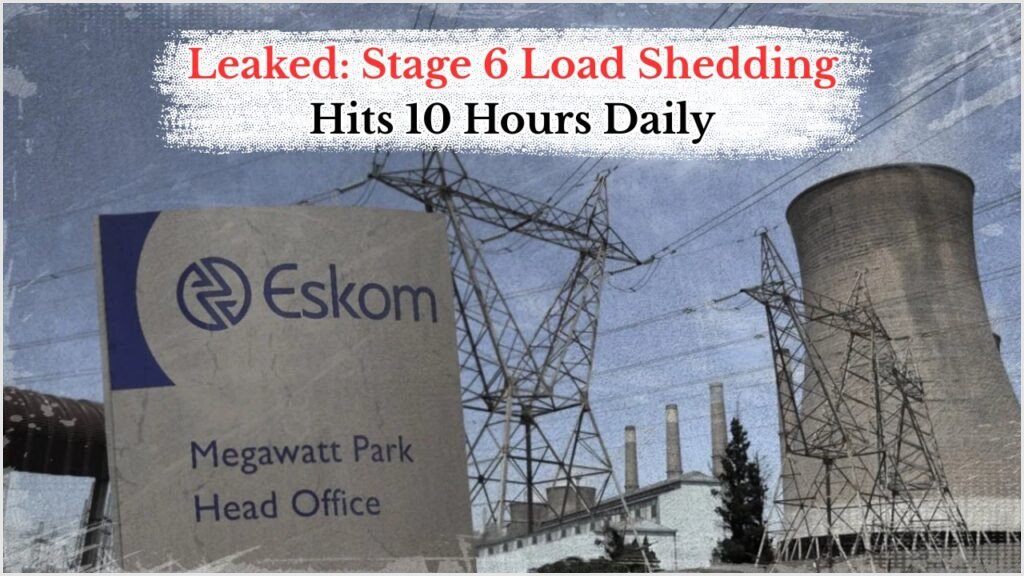Stage 6 Load Shedding in August 2025: South Africans are once again preparing for dark days ahead as Eskom has announced a Stage 6 load shedding schedule for August 2025. This development comes as no surprise to many, given the ongoing challenges faced by the country’s power utility. With power cuts set to intensify, citizens are urged to make necessary arrangements to minimize the impact on their daily lives. From businesses to households, everyone will be affected by these stringent power outages. The situation highlights the critical need for sustainable solutions to the energy crisis that continues to plague the nation.
Understanding Eskom’s Load Shedding Schedule for August 2025
Load shedding in South Africa is a necessary measure to prevent the national grid from collapsing. For August 2025, Eskom has implemented Stage 6 load shedding, which means that the electricity supply will be reduced significantly. This stage involves cutting off power to various areas for up to six hours at a time, several times a day, depending on the demand and supply challenges. This is one of the highest levels of load shedding, indicating severe strain on the national grid. Understanding this schedule is crucial for individuals and businesses to plan their activities accordingly.
 Discover the Fastest Way to Unlock NSFAS Funds: Thousands Swear by This Proven Appeal Format!
Discover the Fastest Way to Unlock NSFAS Funds: Thousands Swear by This Proven Appeal Format!
- Stage 6 involves up to 6,000 MW of power being shed from the grid.
- Outages can last for up to six hours per cycle, with multiple cycles per day.
- Businesses are advised to invest in backup power solutions.
- Households should prepare by stocking up on essentials and ensuring they have alternatives for cooking and lighting.
- Eskom will release daily updates on the load shedding schedule.
- Community support and coordination can help mitigate the impact.
- Efforts are being made to improve the reliability of the power supply.
Impact of Stage 6 Load Shedding on South Africans
The implementation of Stage 6 load shedding has far-reaching implications for South Africans. The immediate impact is felt by businesses that rely heavily on electricity for operations. Retailers, manufacturers, and service providers are particularly vulnerable, as prolonged outages can disrupt production schedules and lead to financial losses. Moreover, load shedding affects the daily routine of households, from cooking to communication, as people have to adjust their schedules around power availability.
| Sector | Impact | Mitigation | Challenges | Opportunities |
|---|---|---|---|---|
| Retail | Reduced sales | Generators | High costs | Adaptation |
| Manufacturing | Production delays | Alternative power | Efficiency | Innovation |
| Services | Service disruption | Schedule adjustments | Customer dissatisfaction | Customer engagement |
| Households | Daily routine changes | Battery-powered devices | Comfort | Energy-saving |
| Education | Interrupted learning | Digital resources | Access | Remote learning |
| Healthcare | Service continuity | Backup systems | Critical care | Resilience building |
| Transport | Traffic congestion | Public transport optimization | Delays | Infrastructure investment |
Preparing for Load Shedding in August 2025
With the announcement of Stage 6 load shedding, preparation becomes key to managing the disruptions. Individuals and businesses need to adopt strategies to minimize the impact. For households, this includes ensuring there are sufficient supplies of necessities such as non-perishable food and water. Investing in solar panels, battery-powered lights, and gas stoves can also provide relief during power cuts. Meanwhile, businesses may need to consider investing in more robust emergency power solutions like generators or UPS systems to ensure continuity of operations.
 August 17, 2025: R1,250 Foster Child Grant Payout Begins – Ensure You Receive Your SMS Alert!
August 17, 2025: R1,250 Foster Child Grant Payout Begins – Ensure You Receive Your SMS Alert!
Strategies for Coping with Load Shedding
- Create a load shedding plan for your household or business.
- Keep electronic devices charged and have power banks available.
- Install surge protectors to safeguard appliances.
- Use load shedding apps to stay informed about schedules.
- Coordinate with neighbors for community solutions.
- Consider alternative energy sources such as solar power.
- Regularly maintain and check backup power systems.
Government and Eskom’s Response to Stage 6 Load Shedding
The South African government and Eskom are under pressure to address the ongoing energy crisis. Various initiatives are being explored to stabilize the power supply, including infrastructure upgrades and exploring renewable energy options. Eskom is working on improving maintenance schedules to reduce the frequency and severity of load shedding. The government is also encouraging private sector investments in the energy sector to boost production capacity. These measures, although in progress, are critical for ensuring a sustainable energy future for the country.
- Infrastructure upgrades to enhance grid stability.
- Promotion of renewable energy projects.
- Public-private partnerships in the energy sector.
- Implementation of demand-side management strategies.
- Encouragement of energy-saving practices among citizens.
- Investments in technology and innovation for energy solutions.
- Strengthening policy frameworks for better energy governance.
Community Initiatives to Mitigate Load Shedding Impact
Community involvement plays an essential role in mitigating the impact of load shedding. Local organizations and neighborhood groups can collaborate to create shared resources and support networks. This may include communal cooking facilities, shared power generators, and coordinated schedules for essential services. By working together, communities can reduce the strain on individual households and ensure that vulnerable members receive the assistance they need during power outages.
Local Community Solutions
- Establishing community-based energy solutions.
- Organizing neighborhood watch groups for safety during blackouts.
- Sharing resources such as generators and power banks.
- Creating communication networks for timely updates.
- Hosting workshops on energy conservation techniques.
Understanding the Future of Load Shedding in South Africa
The long-term resolution of the load shedding issue requires a multifaceted approach. Embracing renewable energy sources, enhancing grid infrastructure, and fostering innovation in energy technology are vital steps towards a sustainable future. Public awareness and involvement are equally important, as citizens play a crucial role in adopting energy-saving practices and supporting renewable energy initiatives. The future of load shedding hinges on a collective effort from government, industry, and communities to work towards a more resilient and self-sufficient energy landscape.
FAQs on Stage 6 Load Shedding
| Question | Answer | Notes |
|---|---|---|
| What is Stage 6 load shedding? | It involves shedding up to 6,000 MW from the grid. | Severe strain on supply. |
| How long does Stage 6 load shedding last? | Outages can last up to six hours per cycle. | Multiple cycles per day. |
| How can I prepare for load shedding? | Have backup power solutions and essentials ready. | Plan ahead. |
| What is the government doing about load shedding? | Investing in infrastructure and renewables. | Long-term solutions. |
| How can communities help during load shedding? | By creating shared resources and support networks. | Community resilience. |
FAQs on Load Shedding in South Africa
What causes load shedding?
Load shedding is caused by an imbalance in electricity demand and supply due to inadequate generation capacity.
How often does Stage 6 load shedding occur?
Stage 6 load shedding occurs during periods of extreme demand and insufficient supply, and its frequency depends on grid conditions.
Can renewable energy prevent load shedding?
While renewable energy can help, a stable grid requires a mix of energy sources and infrastructure improvements.
What are the economic impacts of load shedding?
Load shedding affects business operations, leading to reduced productivity and financial losses.
How can individuals contribute to solving the energy crisis?
By adopting energy-saving habits and supporting renewable energy initiatives.




